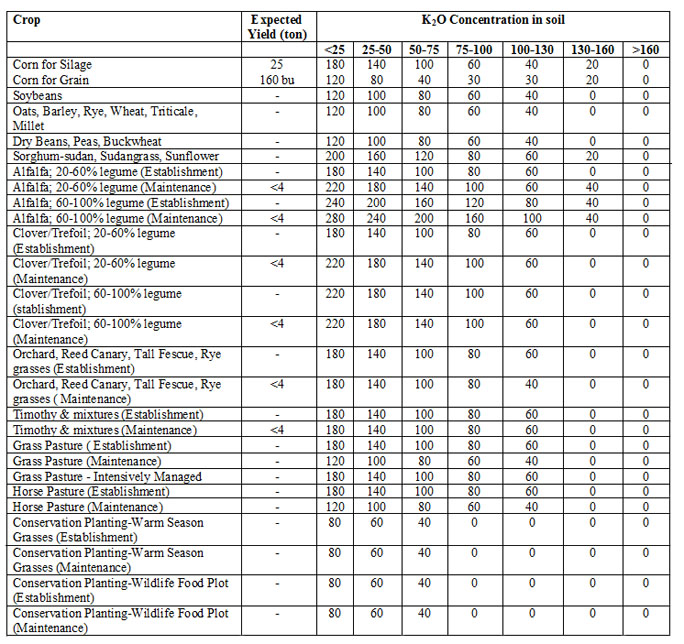Nutrient Recommendations for Field Crops in Massachusetts
Nutrient recommendations for optimum growth and yield must be based on frequent soil testing. The University of Massachusetts recommends soil testing every one to three years and when the crop is rotated.
The University of Massachusetts uses a modified Morgan's solution (1.25 M ammonium acetate, pH 4.8) to analyze most nutrients in its soil testing program. Soil test categories and interpretation of categories are presented in tables 1 and 2.
Table 1: UMass soil test categories for modified Morgan extractable nutrients

Nitrogen:
Nitrogen is critical to plant growth and metabolism. Nitrogen is also an important part of protein and chlorphyll molecules in plants; therfore, N is responsible for the green color of plants and plays an important role in photosynthesis. Plants with a yellowish color are often suffering from N deficiency. Since N is a mobile nutrient, it translocates from older leaves (usually at the lower canopy) to the younger leaves. As a result, N deficiency will be seen first in the lower leaves of a plant.
No soil analysis is used to make the N recommendations on soil lab reports. Nitrogen fertilizer application rates should be determined based on crop species and expected yield. A summary of the N recommendations for agronomic crops is presented in Tables 3 and 4. Nitrogen recommendations must be adjusted for credits from previous legumes in the crop rotation and from past manure applications.
Table 2. Interpretation of soil test categories

Nitrogen status of the soil must be determined when crops begin their active growth. This is especially important in areas such as Massachusetts with significant precipitation in the spring. If all of the required fertilizer is applied at time of planting, a signifcant portion of the N will be lost to leaching.
The pres-sidedress Soil Nitrate Test (PSNT) has been developed for corn in wet regions and fields with high organic matter.
For more information on time and depth of soild sampling for PSNT and to interpret the results visit: https://ag.umass.edu/crops-dairy-livestock-equine/fact-sheets/nitrogen-m...
In summary, PSNT should be done when corn plants are 10-12" tall. Nitrogen application rate for sidedressing corn depends on soil test results and expected yield (Table 3).
Table 3. Nitrogen fertilizer recommendation for corn based on Pre-sidedress Soil Nitrate Test (PSNT)

Table 4. Nitrogen recommendations for field crops (other than corn)

Nitrogen is a mobile nutrient in the soil thus split application of N fertilizer for fall planting including: canola, wheat, tritcale, and barley is highly recommended. For grass hay, divide the N recommendation and apply fertilizer based on the expected yield for each cutting. For grass-legume mixtures, if the legume is more than 50% of the stand, the field should be managed as legume; therefore, no nitrogen is recommended.
For more information on nitrogen management for corn production visit: https://ag.umass.edu/crops-dairy-livestock-equine/fact-sheets/nitrogen-management-for-corn-production
Phosphorus:
Phosphorus recommendations for agronomic crops are based on a combination of the available P soil test and active Al. UMass P soil test categories for modifed Morgan extractable nutrients and interpretations of categories are presented in Tables 1 and 2. Table 5 recommends base P rates for selected P and Al test values. The recommended rates should then be adjusted for a specific agronomic crop using Table 6.
Table 5. Recommended base phosphorus rates for selected available P and Al test values (adjust for agronomic crops with Table 6).

Table 6. Adjustments to base P recommendations for field crops

Potassium:
Recommendations for potassium application rates are presented in Table 7.
Table 7. Potassium recommendations for field crops and conservation planting (lbs K2O/acre)

Resources:
Agronomy Fact Sheets. Cornell University Nutrient Management Spear Program. nmsp.cals.cornell.edu/guideline/factsheets.html
Nutrient Recommendations for Field Crops in Vermont. University of Vermont Extension. pss.uvm.edu/vtcrops/articles/VT_Nutrient_rec_field_crops_1390.pdf
The Agronomic Guide 2013-2014. College of Agricultural Sciences, Penn State. extension.psu.edu/agronomy_guide
This fact sheet was prepared by Masoud Hashemi, Sarah Weis, Kelly Kraemer and John Spargo